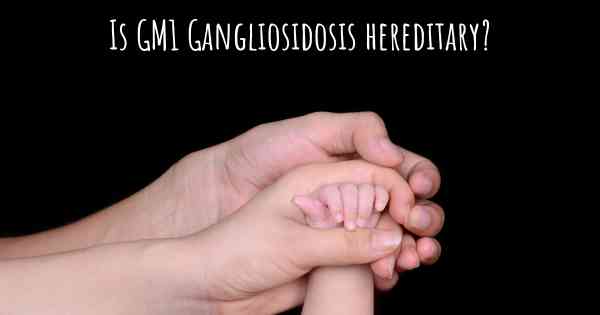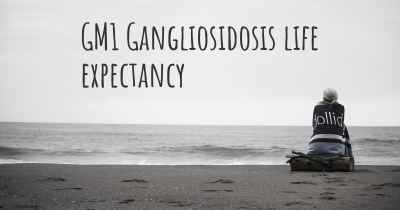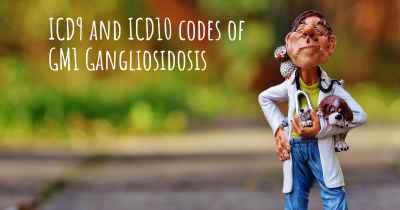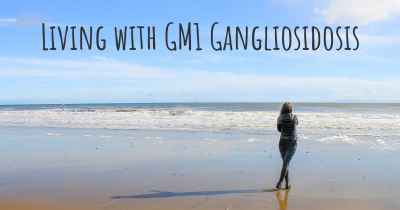Is GM1 Gangliosidosis hereditary?
Here you can see if GM1 Gangliosidosis can be hereditary. Do you have any genetic components? Does any member of your family have GM1 Gangliosidosis or may be more predisposed to developing the condition?

Yes, GM1 Gangliosidosis is a hereditary condition. It is caused by mutations in the GLB1 gene, which is passed down from parents to their children. This genetic disorder affects the body's ability to break down a specific type of fat called gangliosides, leading to the accumulation of these substances in cells. GM1 Gangliosidosis is inherited in an autosomal recessive pattern, meaning that both parents must carry a mutated gene for their child to be affected.
GM1 Gangliosidosis: Hereditary Disorder
GM1 Gangliosidosis is a rare genetic disorder that affects the nervous system. It is caused by a mutation in the GLB1 gene, which is responsible for producing an enzyme called beta-galactosidase. This enzyme plays a crucial role in breaking down a fatty substance called GM1 ganglioside, which is found in the cells of the body.
When there is a mutation in the GLB1 gene, the beta-galactosidase enzyme is either produced in insufficient amounts or is completely absent. As a result, GM1 ganglioside accumulates in the cells, particularly in the brain and other organs, leading to the development of GM1 Gangliosidosis.
Types of GM1 Gangliosidosis
There are three main types of GM1 Gangliosidosis: infantile, juvenile, and adult-onset. The severity and age of onset vary among these types.
1. Infantile GM1 Gangliosidosis:
Infantile GM1 Gangliosidosis is the most common and severe form of the disorder. Symptoms typically appear within the first few months of life. Affected infants may experience developmental delays, muscle weakness, seizures, and an enlarged liver and spleen. They may also have difficulty feeding and may not gain weight at a normal rate. Sadly, the life expectancy for infants with this form of GM1 Gangliosidosis is usually only a few years.
2. Juvenile GM1 Gangliosidosis:
Juvenile GM1 Gangliosidosis is less common and usually presents in early childhood or adolescence. Symptoms may include muscle stiffness, difficulty walking, speech problems, and intellectual disability. Individuals with this form of the disorder may also develop seizures and experience a decline in cognitive function over time. Life expectancy can vary, but individuals with juvenile GM1 Gangliosidosis often have a shortened lifespan.
3. Adult-Onset GM1 Gangliosidosis:
Adult-onset GM1 Gangliosidosis is the rarest form and typically appears in early adulthood. Symptoms may include muscle weakness, difficulty coordinating movements, and psychiatric issues such as depression and anxiety. The progression of symptoms is generally slower compared to the infantile and juvenile forms, and life expectancy can vary widely.
Inheritance Pattern
GM1 Gangliosidosis follows an autosomal recessive inheritance pattern. This means that an affected individual must inherit two copies of the mutated GLB1 gene, one from each parent, to develop the disorder. If both parents are carriers of the mutated gene, there is a 25% chance with each pregnancy that their child will have GM1 Gangliosidosis, a 50% chance that the child will be a carrier like the parents, and a 25% chance that the child will neither have the disorder nor be a carrier.
Genetic Testing and Counseling
Genetic testing can be performed to identify mutations in the GLB1 gene and confirm a diagnosis of GM1 Gangliosidosis. This testing can also be used to determine carrier status in individuals with a family history of the disorder or those who are planning to have children.
Genetic counseling is highly recommended for individuals who have been diagnosed with GM1 Gangliosidosis or have a family history of the disorder. A genetic counselor can provide information about the inheritance pattern, the likelihood of passing on the mutated gene, and available reproductive options.
Treatment and Management
Currently, there is no cure for GM1 Gangliosidosis. Treatment primarily focuses on managing symptoms and improving the quality of life for affected individuals. This may involve a multidisciplinary approach, including physical therapy, occupational therapy, speech therapy, and medications to alleviate specific symptoms such as seizures or muscle stiffness.
Research is ongoing to explore potential therapies, including enzyme replacement therapy and gene therapy, which may offer hope for future treatment options.
Conclusion
GM1 Gangliosidosis is a hereditary disorder caused by mutations in the GLB1 gene. It follows an autosomal recessive inheritance pattern and can manifest in different forms with varying severity and age of onset. Genetic testing and counseling play a crucial role in diagnosing the disorder, determining carrier status, and providing information for family planning. While there is currently no cure, management strategies aim to improve the quality of life for affected individuals. Ongoing research offers hope for potential future treatments.








